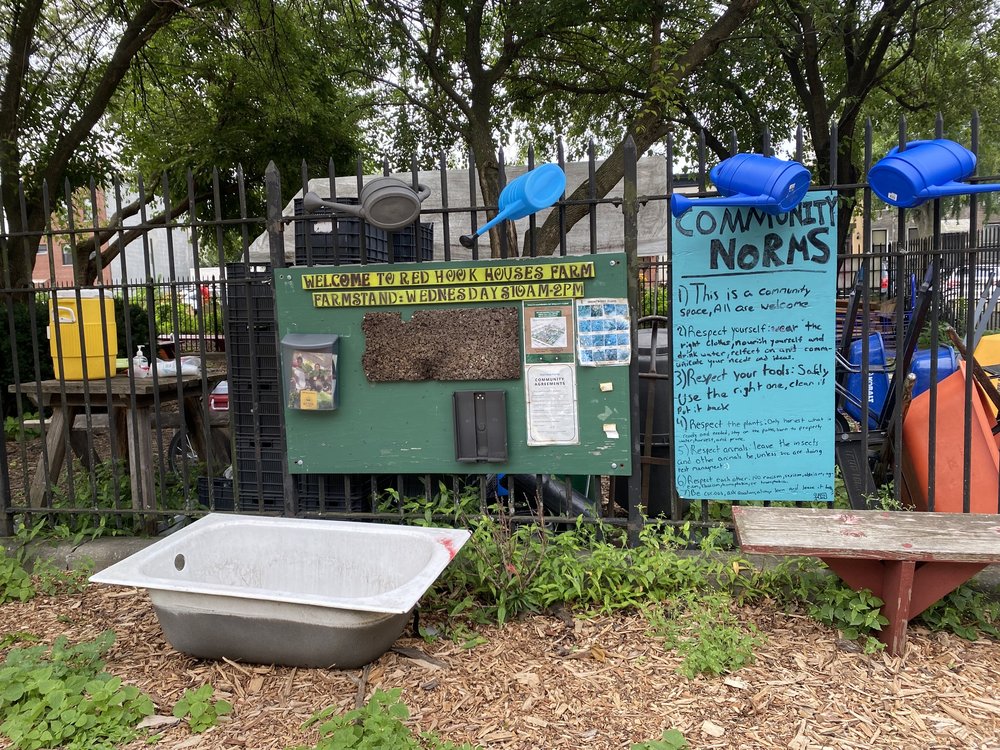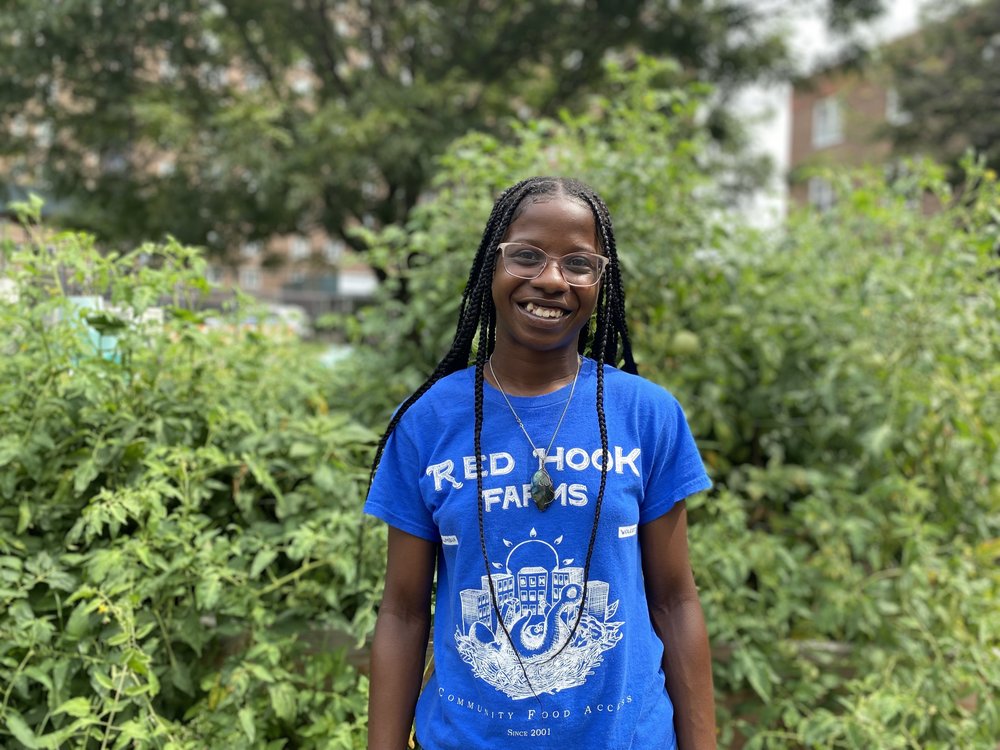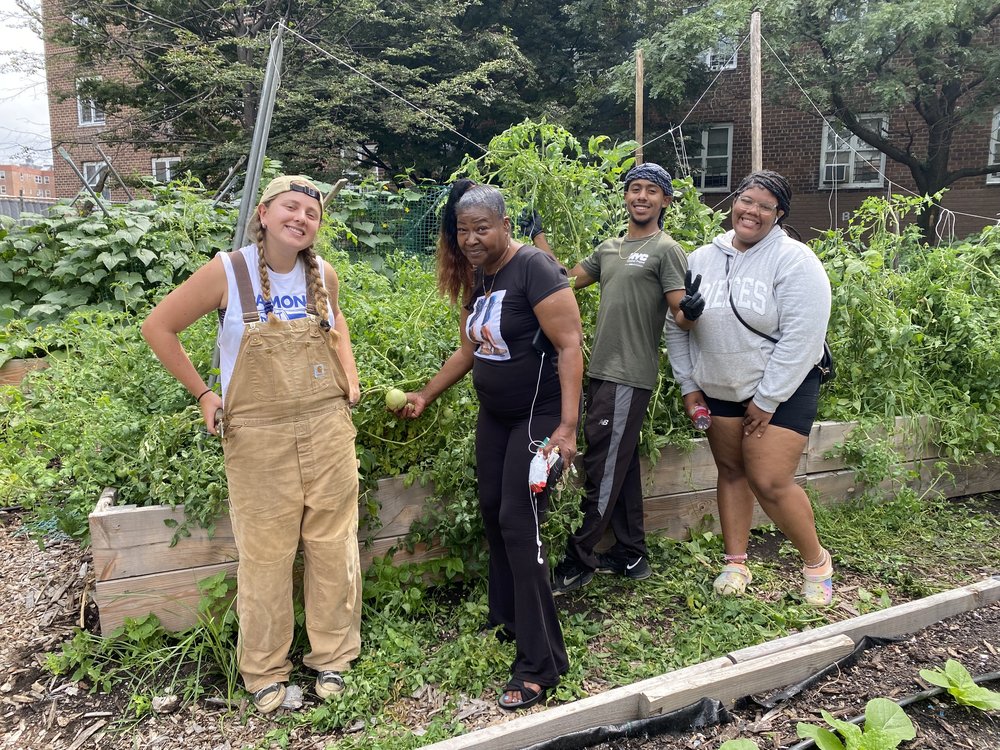Here’s how New Yorkers can join their community gardens
Sept. 5, 2023, 5:30 a.m.
New York City has over 550 community gardens, and they’re all open to the public.

This story is part of our series on community gardens. There are hundreds of community gardens in the New York City area and we're telling some of their stories. We'll end the series on Sept. 8 with a live broadcast from Hattie Carthan Community Garden in Bed-Stuy on WNYC. Listen on 93.9 FM or wnyc.org.
More than 550 community gardens are blossoming across the five boroughs, tucked between high rises or blooming in once-vacant lots of land.
These vital green spaces depend on New Yorkers to plant seeds, pick weeds, and harvest the fruits and veggies, but it’s not always clear how people can get involved.
The good news is these neighborhood treasures are public spaces, and most need committed volunteers who are willing to get their hands dirty, even if it’s for just a few minutes a week.
“I think sometimes people don't realize how much maintenance is required for a community garden,” said Clarisa James, an educator who founded the Garden of Resilience on a vacant city-owned lot in Springfield Gardens, Queens. “Help us take out the garbage, help us with the weeding. It’s as simple as that.”
No community garden is exactly alike, and each has its own leadership structure and specific needs. Some community gardens grow and distribute food and many charge dues. Some have waitlists for plots while others have space available for members willing to put in the work.
In a vast urban sprawl where green spaces are highly coveted, Gothamist spoke with gardeners, volunteers and officials from across the city to lift the veil of secrecy on how everyday New Yorkers can get involved in their local gardens.
Before we get to the goods, you need to know a little background.
Why are these gardens so important?
Each garden exemplifies New Yorkers’ commitment to their communities.
The garden movement began over a half-century ago in Lower Manhattan, which was then home to working-class and immigrant New Yorkers contending with disinvestment and disrepair. As residents reclaimed vacant lots, the local initiative gradually grew into a government-funded program supporting the New Yorkers who turned ugly unused land into thriving and vital community spaces.
People started taking pride in what they grew, and the plots of land became places where neighborhood residents could relax, socialize and celebrate behind the open gates.
“Gardens provide a central place for community connection and they create a space for reclaiming one’s culture,” said Anna Ortega-Williams, a community gardener and professor at Hunter College’s Silberman School of Social Work.
After volunteering at a garden in the Bronx for several years, Ortega-Williams received a grant to work with community farms in every borough to create an oral history project.
She recalled a recent visit to a garden in East New York, where she saw black-eyed peas growing for the first time.
“As someone who identifies as African American, it was very significant for me to see that food I’ve experienced but I’ve never seen,” she said. “It’s an experience to hold that in one’s hand, besides just getting organic fresh food and knowing the farmers around the corner.”
Where can I find a nearby garden?
Many New Yorkers walk by community gardens every day or may even live right around the corner from one. But if you’re not already familiar with a space, the city's parks department makes them easy to find.
The department’s Green Thumb program helps support the gardens, and an interactive map of locations is available on its website. Gardens are especially concentrated in north Brooklyn, northern Manhattan, the South Bronx and on the Lower East Side.
Once you know where to find a garden, GreenThumb officials and gardeners say the best thing to do is simply show up.
“Just visit them,” said Carlos Martinez, Green Thumb's director. “This is the perfect time to explore these spaces and explore your own neighborhood.”
Gardens are required to open for 20 hours a week between April and October; these hours are usually posted on the fence outside. Prospective caretakers can also email the GreenThumb coordinator who serves as a liaison between the city and the garden. The program’s map includes contact information and website links for each community garden.
There’s also social media. Many gardens have Instagram or Facebook pages. The Garden of Resilience’s most recent Facebook album features photos from a wedding held on the grounds earlier this summer.
Do you need to be an expert gardener to join? What sort of experience do people need?
None! And that’s the beauty of community gardens, said Chane Wright, who runs Wolcott Farms in Red Hook, Brooklyn.
“People just come in honestly, and they'll talk to me,” Wright said. “That's all they have to do.”

Wright discussed the garden as she worked with a handful of young volunteers to fix tomato trellises, pull weeds and harvest the most popular item of the summer: cucumbers. She said they want more residents from the surrounding Red Hook Houses public housing complex to join them there or at their partner Columbia Garden.
“We really have a mission to make sure that they're more aware of the farms,” she said.
Wright said interested volunteers can show up to information sessions at the Red Hook Houses on Wednesdays and Saturdays and then return to the garden to handle tasks assigned that day.
Other gardens may have more formal enrollment processes for prospective volunteers or members, as well as specific rules about how often members must work the land.
Nancy Ortiz-Surun, founder of the large La Finca del Sur in the Bronx's Port Morris neighborhood, described her garden’s application and orientation process during GreenThumb’s annual conference last year.
“The emphasis is really on attracting a diverse group of people with a priority on the South Bronx,” Ortiz-Surun said. “You can be a bedholder, you can just work on communal beds, you can be a volunteer and you can be a supporter.”
She said members can also contribute through research or organizing from their homes or offices, but they must commit time to work at La Finca del Sur.
“Can you dedicate eight hours a month to physically be at the farm?” she said. “It is critical to tend to the land and to be able to sustain and be able to work in coalition, our central guiding principle.”
But one key point several gardeners make is to stay humble and demonstrate your commitment to the work and space. Many gardens have waitlists for individual plots that go to the people who have worked the longest and most consistently.

Does it cost anything to get involved?
That depends on where you want to get involved, what you want to do and what your financial situation is.
Many gardens charge fees to cover maintenance and supplies, but they’re willing to waive them if it’s a financial hardship for applicants.
Ask your garden’s manager, or GreenThumb coordinator about any dues.
Others are free for members — as long as they show up.
James, the founder of the Garden of Resilience, said she decided not to charge members since the farm is the only one in her area of southeastern Queens. She said some volunteers perform simple tasks, like dragging the garbage cans to the curbs. Others work harder jobs, like tending to crops and flowers.
But there’s one chore she says they always need help with.
“The most important thing to keep the beauty up is being able to get in there and pull all of those weeds, because weeds have no problem growing,” James said. “They can even grow in concrete, right?”
So show up, and roll up your sleeves, James said: “Even having volunteers come in and weed the garden from 15 minutes to 30 minutes a week would be such a huge contribution in that way.”